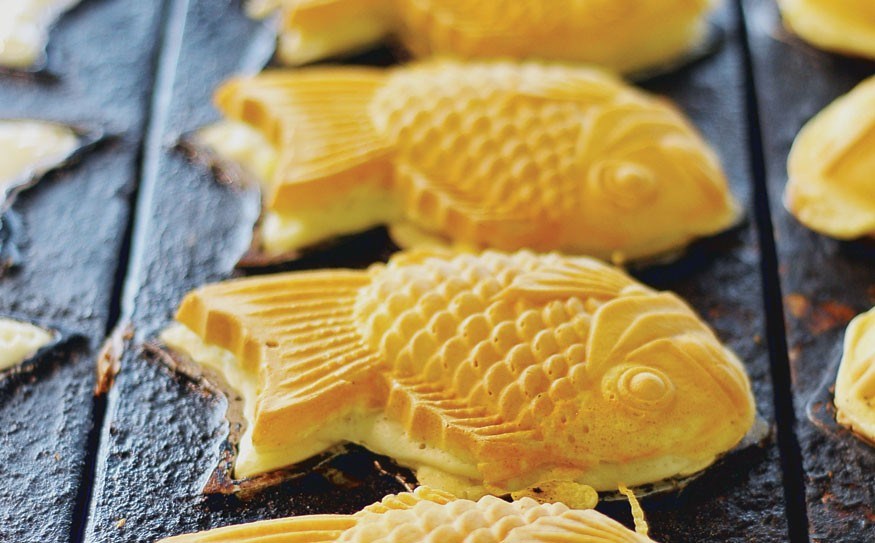Uh-oh. Wrong train. Running up the stairs at the Osaka train station, bound for Kyoto, get to the platform just as the doors are closing, no time to think, jump onboard. I'm headed for Kyoto all right — just not anytime soon. I caught the slow train.
It's a fact of Japanese geography that you can go city-to-city on glorified — in this case not very glorified — subway trains. The biggest hurdle is really psychological. Travelling to a new city is supposed to involve some effort. So you might fail to reflect on the fact that staying in Kobe, Osaka, or Kyoto is essentially like being in all three. Kobe to Osaka is a matter of minutes, and Osaka to Kyoto is a shorter trip than most cross-Tokyo subway rides, especially if you get the rapid service. That takes 10 minutes. The train I'm on is a local, which will take at least an extra half hour to bump along the same route.
Hot tai-yaki!
That's OK, because I'm on a mission. I am going to Kyoto to get me some tai-yaki. Last year in Kyoto I discovered a little stand in the basement of Daimaru department store that served up hot waffle cookies filled with steaming custard. Tai-yaki basically means baked fish, but that's just because the waffles are fish-shaped. There's even a tai-yaki song. Oyoge! Taiyaki-kun (Swim! Taiyaki), by Masato Shimon, was a hugely popular 1970's children's song about an escaped fish (who is eventually caught. Seems kids learn hard lessons early here). At Daimaru I sat down with a hot tai-yaki beside a middle-aged lady wearing a surgical mask who then began to sing the song to me. That, plus the fact that it was so delicious I nearly fainted, stayed with me. And yet I have not found any more tai-yaki stands in any more Japanese department store basements. Hence the slow train to Kyoto.
No cat crossing
I stand at the front of the lead car where I can see the track ahead and watch the driver. It's more interesting than you'd think. Japanese train drivers are a bit of a puzzle. They point. This particular driver, alone and for all he knows unobserved, makes a real meal of it. In an almost ritualistic fashion he slowly raises his arm and deliberately points a white-gloved hand down the track. At what? I'm not sure. He points at approaching trains as soon as they come into view. But sometimes he also points when no trains are visible, possibly at crossings or potential obstructions. Even Japanese subway drivers do this, despite having precious little to point to. Whatever our driver is drawing attention to, he discreetly fails to point out the big ginger cat lying dead between the tracks ahead. It's a sad sight, and mysterious too — how did the poor beast manage to get hit by anything so slow?
Occasionally rapid trains blow past on the other track, mocking the driver and me both. Is it considered a promotion to drive the fast train? Or do the best drivers make the most stops, pointing at obstructions along the way? I notice that the train has a digital speedometer display. Doesn't our driver ever get the overwhelming urge to open it up and see what this baby can do? By the looks of him, emphatically not.
Two young guys stand near me in the train car, both wearing shiny vinyl bomber jackets and matching sneakers. The taller of the two is busy grooming the hairdo of the other one, fussing with the long, tinted strands like a stylist in a salon. It's a rather touching sight.
Fished out
As the train pulls into one station I see a figure down at the far end of the platform, lurking behind a post. He's nowhere near the boarding area. What is he up to? Could he be a jumper, preparing to leap in front of the train? Unlikely — by the time we reach him we won't have enough speed up to give him much more than a mild concussion. The driver doesn't point at him, which concerns me a little. As we pull out he steps away from the pole, an unsmiling young man in a grey parka. He raises his arm and gives us a small wave. And we're past.
Kyoto at last. The Kyoto train station is my favourite modern building in Japan, a massive, airy, whimsical barn that periodically breaks into unexpected sculptural flourishes inside and out. It's about a 25-minute walk down to Shijo-dori and the Daimaru store. I navigate the rows of food vendors and find the spot. But things have changed. There's a new treat on offer, some sort of golden brick made of bean paste and coated in batter. It's not hot, and it's not tai-yaki. The clerk shakes her head — no more tai-yaki here. The oceans are slowly being fished out, and now even custard fish are disappearing.
At least the slow train kept my hopes alive for an extra half hour. If you really can't go home again, it's probably best to take your time getting there.
Steve Burgess loves to tell the stories of his travels here in the Pique and on the Tyee.com.




